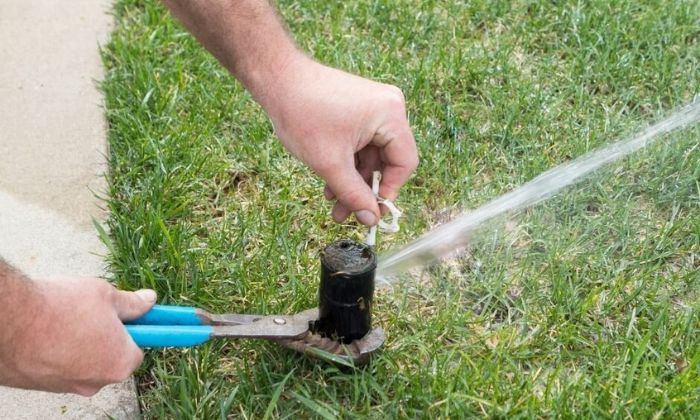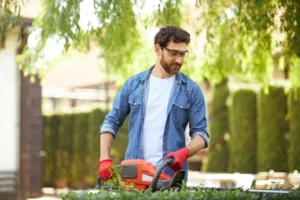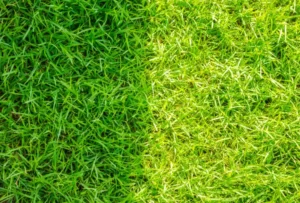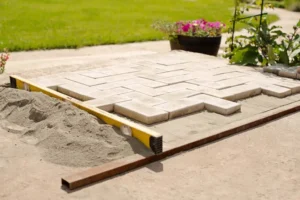Is your lawn looking a bit uneven, or are you noticing dry patches despite regular watering? The issue could be your sprinkler system. Over time, sprinkler systems can experience wear and tear, leading to ineffective watering, higher water bills, and an unhealthy lawn. Don’t worry, though—sprinkler system repair can be simple and straightforward! In this article, we’ll walk you through 7 easy fixes that will have your sprinkler system running efficiently again, saving you time, water, and money.

1. Check for Leaks and Drips in Your Sprinkler System
Problem: Leaks or constant drips in your sprinkler system are a common issue that can waste a lot of water and reduce the efficiency of your irrigation.
Solution: The first step in sprinkler system repair is checking for leaks in your sprinkler heads, pipes, and connections. A leaking sprinkler head or cracked pipe can waste gallons of water, causing puddles in your yard and an uneven lawn. Look for wet spots or puddles near your sprinkler heads—these are signs that a repair is needed. Replace any cracked or damaged heads and tighten loose connections to stop leaks. Regularly checking your sprinkler system for leaks will help save water and maintain an efficient irrigation setup.
2. Adjust Sprinkler Heads for Proper Coverage
Problem: Improperly adjusted sprinkler heads can lead to over-watering or under-watering specific areas of your lawn, leaving patches of dry or oversaturated grass.
Solution: One of the simplest sprinkler system repairs you can do is to adjust the angle and radius of your sprinkler heads. Make sure each head is pointed toward the areas that need watering, and ensure the spray pattern is set to cover the intended space. If necessary, replace sprinkler heads that are damaged or no longer working effectively. Adjusting your sprinkler heads will help you achieve an even distribution of water, ensuring every inch of your lawn gets the hydration it needs.
3. Clean and Unclog Sprinkler Heads
Problem: Dirt, debris, and mineral buildup can clog your sprinkler heads, reducing their water flow and efficiency.
Solution: To prevent clogs, regularly inspect your sprinkler heads for dirt or debris. To clean them, simply unscrew the heads and rinse them under water to remove any obstructions. If the clog is more stubborn, soak the head in vinegar for a few hours to break down mineral buildup. This sprinkler system repair ensures that your sprinklers are working at full capacity, preventing dry patches from forming in your lawn.
4. Replace Broken or Worn Out Parts
Problem: Over time, parts of your sprinkler system can wear out due to weather, usage, or age. A cracked sprinkler head or broken pipe can reduce the overall performance of your system.
Solution: If you notice any broken parts, it’s crucial to replace them as soon as possible. This includes cracked sprinkler heads, damaged pipes, or worn-out nozzles. These components are easy to find at your local hardware store and are simple to replace. Regularly replacing worn parts will ensure that your sprinkler system repair efforts are effective and that your sprinkler system is always in top working condition.
5. Check and Adjust Water Pressure
Problem: Low or inconsistent water pressure can cause your sprinklers to water unevenly, leading to weak spray patterns and dry patches.
Solution: If you notice weak water pressure, it could be due to a malfunctioning pressure regulator. Check your water pressure by turning on the sprinkler system and observing the spray pattern. If the water pressure seems low or inconsistent, the pressure regulator may need to be replaced. Ensuring proper water pressure is one of the most important sprinkler system repairs, as it directly affects how effectively your lawn is watered.
6. Inspect the Controller and Timer Settings
Problem: Often, the issue isn’t the system itself but the settings on your controller or timer. Incorrect programming can lead to your sprinkler system running too often or not often enough.
Solution: Double-check your controller’s settings. Ensure that the watering schedule is tailored to the needs of your lawn and that the timer is set for the right times of day (early morning or late evening is ideal). Incorrect settings can result in over-watering, which wastes water and damages your plants, or under-watering, which leaves your grass thirsty. This simple sprinkler system repair is an easy fix but can have a significant impact on your system’s efficiency.
7. Install a Sprinkler Filter
Problem: Dirt and debris entering the system can clog sprinkler heads and pipes, leading to poor water distribution and inefficiency.
Solution: Installing a filter at the beginning of your sprinkler system can help prevent debris from entering and clogging your pipes and heads. This sprinkler system repair reduces maintenance needs and extends the life of your system. Filters are easy to install and can save you from frequent cleaning and repairs down the road. For expert Bay Area landscape design and irrigation system repairs, choose Lakota Design Group to keep your system running smoothly and efficiently.
Conclusion
Maintaining a healthy, lush lawn doesn’t have to be a constant battle. By following these 7 easy sprinkler system repair tips, you’ll ensure that your system runs efficiently, saving water and preventing dry, patchy spots in your yard. Regular maintenance and timely repairs can make a big difference in the health of your lawn and help you avoid costly repairs in the future.
If you’re not comfortable handling these repairs yourself, choose Lakota Design Group for professional Irrigation System Repair. A properly functioning sprinkler system is key to keeping your lawn green and vibrant all year round.
FAQs
Why is my sprinkler system causing dry patches in my lawn?
Dry patches are often due to clogged heads, leaks, or improper adjustments. Check for issues with your sprinkler heads or system settings.
How do I know if my sprinkler system has a leak?
Look for wet spots or puddles around your sprinkler heads or pipes; these are common signs of a leak in the system.
Can I repair my sprinkler system myself?
Yes, many issues like adjusting heads or cleaning clogs are simple DIY repairs, but for complex issues, professional help may be needed.
How do I clean clogged sprinkler heads?
Unscrew the heads, rinse them under water, and soak in vinegar if there’s mineral buildup to remove dirt and debris.





